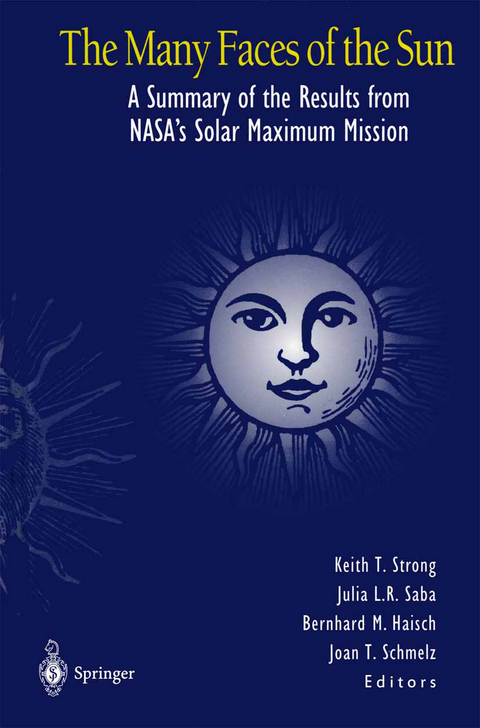
The Many Faces of the Sun
Springer-Verlag New York Inc.
978-1-4612-7145-1 (ISBN)
1. The Solar Maximum Mission.- 1.1 The Origins of the Mission.- 1.2 Scientific Objectives of the Mission.- 1.3 The SMM Instrument Package.- 1.4 Scientific Discoveries.- 1.5 Concluding Remarks.- 2. Solar Irradiance Variations.- 2.1 Development of Solar Irradiance Monitors.- 2.2 Models of the Solar-Cycle TSI Variation.- 2.3 ACRIM I and Succeeding Observations.- 2.4 The Long-Term Climate TSI Data Base.- 3. Active Regions.- 3.1 Magnetic Field Strength and Structure.- 3.2 Dynamics and Heating of the Solar Corona.- 3.3 Transition Region Brightenings: UV Microflares.- 3.4 Sunspots.- 3.5 Prominences and Filaments.- 4. Coronal Abundances.- 4.1 Flare X-Ray Measurements from BCS.- 4.2 FCS Abundances.- 4.3 Determination of Solar Abundances by Solar Flare ?-Ray Spectrometry.- 4.4 Solar Energetic Particles.- 4.5 Theory of Abundance Fractionation.- 5. Coronal Mass Ejections.- 5.1 Nature and Structure of Coronal Mass Ejections.- 5.2 The Propagation of Mass Ejections Through the Corona.- 5.3 The Origin of Coronal Mass Ejections.- 5.4 Summary.- 6. Preflare Activity.- 6.1 General Activity in Active Regions.- 6.2 Precursors to Major Flares.- 6.3 Chromospheric Evaporation.- 6.4 The Onset of Coronal Mass Ejections.- 6.5 Surges.- 6.6 Conclusions.- 7. Particle Acceleration in Flares.- 7.1 The “Pre-SMM” Paradigm.- 7.2 High-Energy Flare Observations.- 7.3 Mechanisms for Particle Acceleration.- 7.4 Summary.- 8. Nonthermal Flare Emissions.- 8.1 Statistical Aspects of Hard X-Ray Flares.- 8.2 Particle Acceleration and Injection.- 8.3 Particle Trapping and Precipitation.- 8.4 Flare Diagnostics from Hard X-Ray/Radio Observations.- 9. Chromospheric Evaporation Theory.- 9.1 Pre-SMM Results.- 9.2 Early SMM Results.- 9.3 Later SMM Results.- 9.4 Future Developments.- 9.5 Conclusions.- 10. FlareDynamics.- 10.1 Results from Soft X-Ray Spectra.- 10.2 Chromospheric Evaporation.- 10.3 Nature of Nonthermal Line Broadenings.- 10.4 Concluding Remarks.- 11. Ultraviolet Flare Studies.- 11.1 UV Flare Plasma Diagnostics.- 11.2 UV and Hard X-Ray Bursts.- 11.3 Flare Topology: Interacting Loops.- 11.4 Discussion.- 12. The Gradual Phase of Flares.- 12.1 Heating and Cooling in the Gradual Phase.- 12.2 Emission Measure-Temperature Diagrams.- 12.3 Flaring Arches.- 12.4 Gradual Phase of Eruptive Flares.- 12.5 Postflare Giant Arches.- 12.6 Giant Arches: Modeling and Interpretation.- 13. Spectroscopy and Atomic Physics.- 13.1 Theory of Line Intensities.- 13.2 Density-Sensitive Line Ratios.- 13.3 Temperature-Sensitive Line Ratios.- 13.4 Element Abundances.- 13.5 Photospheric X-Ray Lines.- 13.6 Checking and Correcting Atomic Data.- 13.7 Summary and Future Directions.- 14. Solar-Terrestrial and Terrestrial Science.- 14.1 SMM’s Impact on Solar-Terrestrial Studies.- 14.2 ?-Rays from the Earth.- 14.3 Transient Radiation Belts from Orbiting Nuclear Reactors.- 14.4 Mesospheric Chemistry Studies with UVSP.- 15. Solar-Stellar Connection.- 15.1 Stellar Coronae and Acoustic Heating.- 15.2 The Dividing Line.- 15.3 The Rotation-Activity Relation: Calibrating the Dynamo.- 15.4 Age versus Activity: The Evolution of the Sun.- 15.5 Stellar Activity Cycles.- 15.6 Mapping Stellar Surfaces.- 15.7 Flares on Other Stars.- 15.8 What is the Range of Stellar Power Ratios?.- 15.9 Conclusion.- 16. Comet Observations.- 16.1 Comet Halley and Comet Machholz.- 16.2 Comet Machholz (1988 XV).- 16.3 Kreutz Family of Sungrazing Comets.- 16.4 Summary.- 17. Cosmic Studies.- 17.1 Hard X-Ray Sources.- 17.2 ?-Ray Bursts.- 17.3 ?-Ray Observations of Recent Supernovae.- 17.4 ?-Ray Observations of Recent Novae.- 17.5Searches for ?-Ray Transients.- 17.6 Galactic Observations.- 17.7 Summary of ?-Ray Line Observations.- References.- Acronyms.- Acknowledgment of Copyright.
| Zusatzinfo | XXIV, 610 p. |
|---|---|
| Verlagsort | New York, NY |
| Sprache | englisch |
| Maße | 155 x 235 mm |
| Themenwelt | Naturwissenschaften ► Physik / Astronomie ► Astronomie / Astrophysik |
| ISBN-10 | 1-4612-7145-2 / 1461271452 |
| ISBN-13 | 978-1-4612-7145-1 / 9781461271451 |
| Zustand | Neuware |
| Haben Sie eine Frage zum Produkt? |
aus dem Bereich


